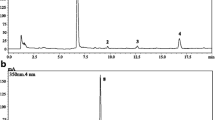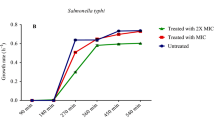Abstract
The antioxidant activities of extracts from leaves of the medicinal plants growing in Siberia were examined. Total antioxidant activity was determined using in vitro methods including DPPH (2,2-diphenyl-1-picrylhydrazyl radical) free radical scavenging assay, chelating capacity assay with ferrozine, evaluation of capacity to protect plasmid DNA against oxidative damage, measurement of H2O2 production, and measurement of total flavonoid and tannin content as well. Using in vivo experiments, we also evaluated capacities of the plant extracts to protect bacteria Escherichia coli against bacteriostatic and bactericidal effects of H2O2, and influence of the plant extracts on expression of antioxidant gene katG, encoding catalase. The extracts from Chamerion angustifolium, Filipendula vulgaris and Pyrola rotundifolia indicated the highest levels of antioxidant activity both in vivo and in vitro. Our data suggest that the extracts of the tested plants may provide antioxidant effects on bacteria simultaneously through different pathways, including direct radical scavenging, iron chelation and induction of genes encoding antioxidant enzymes.


Similar content being viewed by others
References
Afanas’ev IB, Dorozhko AI, Brodskii AV, Kostyuk VA, Potapovitch AI (1989) Chelating and free scavenging mechanisms of inhibitory action of rutin and quercetin in lipid peroxidaton. Biochem Pharmacol 38:763–1769
Aslund F, Zheng M, Beckwith J, Storz G (1999) Regulation of the OxyR transcription factor by hydrogen peroxide and the cellular thiol-disulfide status. Proc Natl Acad Sci USA 96:6161–6165
Belikov VV, Shraiber MC (1970) Methods of analysis of flavonoid compounds. Pharmacia (USSR) 1:66–72
Edenharder R, Grunhage D (2003) Free radical scavenging abilities of flavonoids as mechanism of protection against mutagenicity induced by tert-butyl hydroperoxide or cumene hydroperoxide in Salmonella typhimurium TA102. Mutat Res 540:1–18
Ferrali M, Signorini C, Caciotti B, Sugherini L, Ciccoli L, Giachetti D, Comporti M (1997) Protection against oxidative damage of erythrocyte membrane by the flavonoid quercetin and its relation to iron chelating activity. FEBS Lett 416:123–129
González-Flecha B, Demple B (1997) Homeostatic regulation of intracellular hydrogen peroxide concentration in aerobically growing Escherichia coli. J Bacteriol 179:382–388
Halliwell B, Rafter J, Jenner A (2005) Health promotion by flavonoides, tocopherols, tocotrienols, and other phenols: direct or indirect effects? Antioxidant or not? Amer J Clin Nutr 81:268S–276S
Hanasaki Y, Ogawa S, Fukui S (1994) The correlation between active oxygens scavenging and antioxidative effects of flavonoids. Free Radic Biol Med 16:845–850
Hoshino N, Kimura T, Jamaji A, Ando T (1999) Damage to the cytoplasmic membrane of Escherichia coli by catechin-copper (II) complexes. Free Radic Biol Med 27:1245–1250
Kim H-J, Chen F, Wang X, Chung HY, Jin Z (2005) Evalution of antioxidant activity of Vetiver (Vetiveria zizanioides L.) oil and identification of its antioxidant constituents. J Agric Food Chem 53:7691–7695
Masaki H, Sakaki S, Atsumi T, Sakurai H (1995) Active-oxygen scavenging activity of plant extracts. Biol Pharm Bull 18:162–166
Melidou M, Riganakos K, Galaris D (2005) Protection against nuclear DNA damage offered by flavonoids in cells exposed to hydrogen peroxide: The role of iron chelation. Free Radic Biol Med 39:1591–1600
Miller JH (1972) Experiments in molecular genetics. Cold Spring Harbor, New York
Nijveldt RJ, van Nood E, van Hoorn DEC, Boelens PG, van Norren K, Leeuwen PAM (2001) Flavonoids: a review of probable mechanisms of action and potential applications. Amer J Clin Nutr 74:418–425
Oktyabrsky O, Vysochina G, Muzyka N, Samoilova Z, Kukushkina T, Smirnova G (2009) Assessment of antioxidant activity of plant extracts using microbial test systems. J Appl Microbiol 106:1175–1183
Park S, Imlay JA (2003) High levels of intracellular cysteine promote oxidative DNA damage by driving the Fenton reaction. J Bacteriol 185:1942–1950
Pietta PG (1998) Flavonoids in medicinal plants. In: Rice-Evans CA, Packer L (eds) Flavonoids in health and disease. Dekker, New York, pp 61–110
Rice-Evans CA, Miller NJ, Bolwell PG, Bramley PM, Pridham JB (1995) The relative antioxidant actuvities of plant-derived polyphenolic flavonoids. Free Radic Res 22:375–383
Scalbert A (1991) Antimicrobial properties of tannins. Phytochemistry 30:3875–3883
Seaver LC, Imlay JA (2001) Alkyl hydroperoxide reductase is the primary scavenger of endogenous hydrogen peroxide in Escherichia coli. J Bacteriol 183:7173–7181
Sestili P, Diamantini G, Bedini A, Cerioni L, Tommasini I, Tarzia G, Cantoni O (2002) Plant- derived phenolic compounds prevent the DNA single-strand breakage and cytotoxicity induced by tert-butyl-hydroperoxide via an iron-chelating mechanism. Biochem J 364:121–128
Shahidi F, Janitha P, Wanasundara PD (1992) Phenolic antioxidants. Crit Rev Food Sci Nutr 32:67–103
Shikov AN, Poltanov EA, Dorman HJD, Makarov VG, Tikhonov VP, Hultinen R (2006) Chemical composition and in vitro antioxidant evaluation of commercial water-soluble willow herb (Epilobium angustifolium) extracts. J Agric Food Chem 54:3617–3624
Shyur L-F, Tsung J-H, Chen J-H, Chiu C-Y, Lo J-P (2005) Antioxidant properties of extracts from medicinal plants popularly used in Taiwan. Inter J Appl Sci Eng Technol 3:195–202
Singleton VL (1987) Oxygen with phenols and related reactions in musts, wines, and model systems: observations with practical implications. Am J Enol Vitic 38:69–77
Smirnova GV, Samoylova ZY, Muzyka NG, Oktyabrsky ON (2009) Influence of polyphenols on Escherichia coli resistance to oxidative stress. Free Radic Biol Med 46:759–768
Smith AH, Imlay JA, Mackie RI (2003) Increasing the oxidative stress response allows Escherichia coli to overcome inhibitory effects of condensed tannins. Appl Environ Microbiol 69:3406–3411
State Pharmacopoeia of USSR (1987) Vol. XI, Meditsina, Moscow
Storz G, Imlay JA (1999) Oxidative stress. Curr Opin Microbiol 2:188–194
Tao K, Makino K, Yonei S, Nacata A, Shinagawa H (1989) Molecular cloning and nucleotide sequencing of oxyR, the positive regulatory gene of a regulon for an adaptive response to oxidative stress in Escherichia coli: homologies between OxyR protein and a family of bacterial activator proteins. Mol Gen Genet 218:371–376
Acknowledgments
The authors are grateful to doctor K. Tao for kindly providing the strain of bacteria. This work was supported by the grant of « Programs of integration projects of Ural Division of the Russian Academy of Sciences ».
Author information
Authors and Affiliations
Corresponding author
Rights and permissions
About this article
Cite this article
Smirnova, G.V., Vysochina, G.I., Muzyka, N.G. et al. Evaluation of antioxidant properties of medical plants using microbial test systems. World J Microbiol Biotechnol 26, 2269–2276 (2010). https://doi.org/10.1007/s11274-010-0417-4
Received:
Accepted:
Published:
Issue Date:
DOI: https://doi.org/10.1007/s11274-010-0417-4




